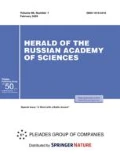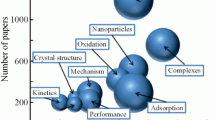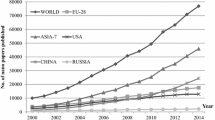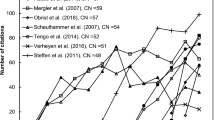Abstract—
The results of a scientometric analysis of publications of scientific chemical organizations for 2015–2019, presented in the Web of Science database, are given. Seven groups of scientific categories are considered in the analysis: chemistry, electrochemistry, green & sustainable science & technology, materials sciences, nanotechnology, polymers, and quantum calculations. For each group, the contribution of articles published in journals of different quartiles has been estimated. It is shown that the role of international cooperation in the creation of articles depends significantly on the subject area. Keywords characterizing each of the subject areas analyzed have been determined.









Similar content being viewed by others
REFERENCES
A. Martín-Martín, E. Orduna-Malea, M. Thelwall, and E. D. López-Cózar, “Google Scholar, Web of Science, and Scopus: A systematic comparison of citations in 252 subject categories,” J. Informetrics 12 (4), 1160–1177 (2018).
J. Zhu and W. Liu, “A tale of two databases: The use of Web of Science and Scopus in academic papers,” Scientometrics 123 (1), 321–335 (2020).
I. V. Zibareva, L. Yu. Ilina, and B. L. Alperin, “Russian Science Citation Index: Areas for development identified by active users,” Sci. Tech. Inf. Process. 45 (2), 106–109 (2018).
M.-A. Sicilia, S. Sánchez-Alonso, and E. García-Barriocanal, “Comparing impact factors from two different citation databases: The case of Computer Science,” J. Informetrics 5 (4), 698–704 (2011).
G. Ennas and M. C. Di Guardo, “Features of top-rated gold open access journals: An analysis of the Scopus database,” J. Informetrics 9 (1), 79–89 (2015).
O. E. Sala, C. G. Boone, B. L. Turner, and C. M. Currier, “The sustainability publication gap and its implications,” Curr. Opin. Environ. Sustain. 39, 39–43 (2019).
H. Hottenrott and C. Lawson, “A first look at multiple institutional affiliations: A study of authors in Germany, Japan, and the UK,” Scientometrics 111 (1), 285–295 (2017).
Y. Reingewertz and C. Lutmar, “Academic in-group bias: An empirical examination of the link between author and journal affiliation,” J. Informetrics 12 (1), 74–86 (2018).
M. Walther and B. Melsheimer, “Automated author affiliation processing using Scopus data,” Procedia Comp. Sci. 146, 53–59 (2019).
X. Lu, S. Kataria, W. J. Brouwer, et al., “Automated analysis of images in documents for intelligent document search,” Int. J. Doc. Anal. Recog. 12 (2), 65–81 (2009).
D. Tkaczyk, P. Szostek, M. Fedoryszak, et al., “CERMINE: Automatic extraction of structured metadata from scientific literature,” Int. J. Doc. Anal. Recog. 18 (4), 317–335 (2015).
Z. Nasar, S. W. Jaffry, and M. K. Malik, “Information extraction from scientific articles: A survey,” Scientometrics 117 (3), 1931–1990 (2018).
N. Milosevic, C. Gregson, R. Hernandez, and G. Nenadic, “A framework for information extraction from tables in biomedical literature,” Int. J. Doc. Anal. Recog. 22 (1), 55–78 (2019).
M. Bukowski, S. Geisler, T. Schmitz-Rode, and R. Farkas, “Feasibility of activity-based expert profiling using text mining of scientific publications and patents,” Scientometrics 123 (2), 579–620 (2020).
W. Liu, L. Tang, and G. Hu, “Funding information in Web of Science: An updated overview,” Scientometrics 122 (3), 1509–1524 (2020).
R. Long, A. Crawford, M. White, and K. Davis, “Determinants of faculty research productivity in information systems: An empirical analysis of the impact of academic origin and academic affiliation,” Scientometrics 78 (2), 231–260 (2008).
C. A. D’Angelo and N. J. van Eck, “Collecting large-scale publication data at the level of individual researchers: A practical proposal for author name disambiguation,” Scientometrics 123 (2), 883–907 (2020).
Z. Xie, “Predicting the number of coauthors for researchers: A learning model,” J. Informetrics 14 (2), 1–16 (2020).
Y. Zhou, H. Cheng, Q. Li, and W. Wang, “Diversity of temporal influence in popularity prediction of scientific publications,” Scientometrics 123 (1), 383–392 (2020).
L. Y. Il’ina, I. V. Zibareva, and A. A. Vedyagin, “Reflection of reflections: Scientist’s activity in the mirror of bibliometrics,” Kinet. Catal. 59 (5), 652–666 (2018).
I. V. Zibareva, L. Y. Ilina, B. L. Alperin, and A. A. Ve-dyagin, “The scientometric profile of Boreskov Institute of Catalysis,” Herald Russ. Acad. Sci. 89 (3), 259–270 (2019).
I. V. Zibareva, L. Y. Ilina, B. L. Alperin, and A. A. Ve-dyagin, “Boreskov Institute of Catalysis: Sixty years of research and development,” React. Kinet. Mech. Catal. 127 (1), 3–17 (2019).
I. V. Zibareva, A. A. Vadyagin, and L. Y. Ilina, “ Bibliometric performance of a scientific organization in retrospect and in perspective,” Tr. GPNTB SO RAN, No. 12-1, 337–346 (2017).
I. V. Zibareva, A. A. Vedyagin, and V. I. Bukhtiyarov, “Kinetika i Kataliz: 55 years in the bibliometric dimension,” Kinet. Catal. 57 (1), 1–16 (2016).
B. L. Alperin, I. V. Zibareva, and A. A. Vedyagin, “Analysis of scholarly articles’ publication speed with SciAct CRIS system,” Bibliosfera, No. 1, 83–92 (2020).
I. V. Zibareva, L. Y. Ilina, and A. A. Vedyagin, “Catalysis by nanoparticles: The main features and trends,” React. Kinet. Mech. Catal. 127 (1), 19–24 (2019).
P. T. Anastas and J. C. Warner, Green Chemistry: Theory and Practice (Oxford Univ. Press, New York, 1998).
Funding
This article was supported by the Russian Ministry of Science and Education, subsidy agreement no. 05.601.21.0020 of November 8, 2019 (unique identifier of the agreement RFMEFI60119X0020), Study of the Mechanisms of Adaptive Formation of Human Resources for Carrying Out Various-Scale Research Programs in Priority Areas of the Scientific and Technological Development of the Russian Federation.
Author information
Authors and Affiliations
Corresponding authors
Additional information
Translated by B. Alekseev
Valentina Vladimirovna Koroleva is an Engineer of the Laboratory of Complex Systems Mathematical Modeling of the Lebedev Physical Institute, RAS (FIAN). Oleg Viktorovich Ivanov, Cand. Sci. (Phys.‒Math.), is a Senior Researcher of the FIAN Laboratory of Superconductivity Theory and Statistical Physics of Complex Systems and the FIAN Laboratory of Complex Systems Mathematical Modeling and Deputy Director for Development of the same institute. Alexei Anatol’evich Vedyagin, Cand. Sci. (Chem.), is Head of the Laboratory of Nanostructured Catalysts and Sorbents and Deputy Director for Science of the Boreskov Institute of Catalysis of the RAS Siberian Branch (IC SB RAS) and a Leading Researcher of the FIAN Laboratory of Complex Systems Mathematical Modeling. Anton Sergeevich Lyadov, Cand. Sci. (Chem.), is Head of the Sector of Petroleum Chemistry of the Topchiev Institute of Petrochemical Synthesis (TIPS RAS) and a Senior Researcher of the FIAN Laboratory of Complex Systems Mathematical Modeling. Andrei Vladimirovich Leonidov, Dr. Sci. (Phys.‒Math.), is a Leading Researcher of the FIAN Laboratory of High Energies. Andrei Vladimirovich Kolobov, Cand. Sci. (Phys.‒Math.), is a Senior Researcher of the FIAN Laboratory of Complex Systems Mathematical Modeling and Deputy Director for Science of this institute.
Rights and permissions
About this article
Cite this article
Koroleva, V.V., Ivanov, O.V., Vedyagin, A.A. et al. Publication Activity as a Research Efficiency Indicator by the Example of Chemical Organizations. Her. Russ. Acad. Sci. 90, 607–617 (2020). https://doi.org/10.1134/S1019331620050147
Received:
Revised:
Accepted:
Published:
Issue Date:
DOI: https://doi.org/10.1134/S1019331620050147




